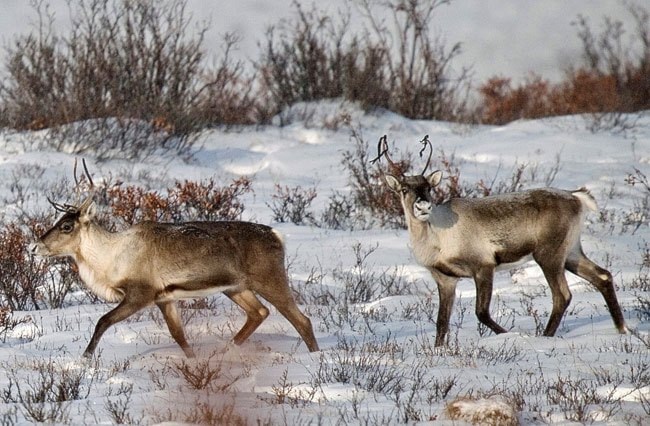Canada’s barren-ground caribou herds have declined dramatically in recent years, and a national committee is now calling for them to be listed as threatened.
But the Porcupine caribou herd, which migrates through the Yukon, Alaska and the Northwest Territories, is bucking the downward trend, with a population that has grown by more than 70,000 since 2001.
The Committee on the Status of Endangered Wildlife in Canada (COSEWIC) met at the end of November and released its assessment on Dec. 5.
Justina Ray, who led the caribou assessment, said most of the 15 barren-ground caribou herds in Canada have declined by more than 50 per cent since the late 1980s.
Some herds have lost much more than that. The Baffin Island caribou herd in Nunavut has dwindled from 235,000 animals in 1991 to just 3,000 in 2014. And the Bathurst herd in the Northwest Territories has dropped from 472,000 animals in 1986 to 20,000 in 2015.
Ray said scientists don’t know why caribou numbers are shrinking so fast. Herds do fluctuate naturally, but she said humans are likely also contributing to the decline.
“There is much more development in quite a number of the ranges,” she said, using increased mining exploration around Bathurst Inlet as an example.
She said climate change is likely also having an impact, though it’s not well understood.
A decline of more than 50 per cent over 30 years would have been enough to call the barren-ground caribou endangered, not just threatened.
But Ray said the committee settled on the milder designation in part because the Porcupine herd, about 25 per cent of the total barren-ground population, is doing so well.
The Porcupine herd dropped from 178,000 animals in 1989 to a low of 123,000 in 2001. But it has since grown again, to 197,000 in 2013.
Ray said the Porcupine herd may be doing better than other populations because there’s little development over much of its range.
But the herd likely owes part of its success to good management, she said.
The Porcupine Caribou Management Board was established in the 1980s between the governments of the Yukon, the Northwest Territories and Canada.
Joe Tetlichi, the board’s chair, said the organization “took the bull by the horns” when the herd began to decline. That meant going out to the communities and talking about how the numbers were changing.
“That really was an eye-opener to the communities,” he said.
Tetlichi said Indigenous communities now take the issue so seriously that in 2006, when it was thought that the herd might have dropped below 100,000 animals, they voluntarily eliminated cows from their harvest for four years.
“We’re in a place now where we’re comfortable in regards to if the herds go down,” he said.
Tom Jung, the Yukon government’s senior wildlife biologist, said the Porcupine herd “is probably a good model of how to manage a barren-ground caribou population that does fluctuate.”
But he said the status of caribou across the North is “quite dire.”
Indigenous knowledge indicates there have been declines in the past, he said, but nothing on this scale.
“This is a bit of a puzzling and unprecedented phenomenon.”
Caribou populations to the west of the Porcupine herd in Alaska have also dwindled to less than half what they were 10 or 15 years ago, he said.
COSEWIC’s assessment will now be presented to federal Environment Minister Catherine McKenna. After consultation, McKenna will make a decision about whether to list barren-ground caribou as threatened under the Species At Risk Act.
If that happens, Jung said, caribou protections would be increased on federal lands, including national parks. But he said there shouldn’t be major changes to hunting regulations on non-federal lands in the Yukon, as long as Porcupine caribou numbers stay fairly stable.
Still, there are other threats facing the herd. Northern Cross has filed an application to continue exploratory drilling for oil and gas in the Eagle Plains region of the Yukon. And the election of Donald Trump in the United States has renewed concerns about possible oil drilling in the Arctic National Wildlife Refuge in Alaska.
But Tetlichi said northerners have been successful at drumming up support for Porcupine caribou protection thus far.
“It’s proven we get results from educating the grassroots people,” he said. “We just have to continue on.”
Contact Maura Forrest at maura.forrest@yukon-news.com
